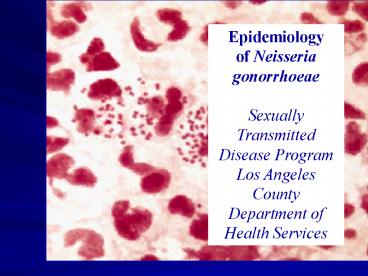Epidemiology - PowerPoint PPT Presentation
1 / 22
Title:
Epidemiology
Description:
Epidemiology of Neisseria gonorrhoeae Sexually Transmitted Disease Program Los Angeles County Department of Health Services – PowerPoint PPT presentation
Number of Views:35
Avg rating:3.0/5.0
Title: Epidemiology
1
Epidemiology of Neisseria gonorrhoeae Sexually
Transmitted Disease Program Los Angeles
County Department of Health Services
2
Overview
- Facts about Gonorrhea
- National Trends
- Counts
- Rates
- Health People 2010
- Los Angeles County
- Counts
- Rates
- Key Points to Ponder
- Data Limitations
3
Facts about Gonorrhea
- Second most common bacterial STD
- Incubation period is 2-7 days GC divides every
20-30 minutes - Males purulent (pus) discharge
- Females cervicitis (mostly asymptomatic)
- Causes PID, infertility, ectopic pregnancy, and
conjunctivitis - Increase transmission and susceptibility to HIV
2-5 fold
4
National Trends
5
Reported Sexually Transmitted Diseases United
States, 2004
Source CDC Sexually Transmitted Disease Report,
2004
6
Healthy People 2010
- Health objectives for the Nation
- Based on initiatives
- 1979 Surgeon Generals Report, Health People
- Healthy People 2000 National Health Promotion
and Disease Prevention Objectives - Measurement of health outcomes over time
- 467 HP2010 objectives tracked by 196 data sources
- Includes 23 major data sources (e.g., NHIS)
7
HP 2010 Goal Gonorrhea (25-2)
- Reduce gonorrhea to 19 cases per 100,000
population - Progress monitored by information gathered from
State and local Health Department STD Programs
8
Gonorrhea Rates United States, 19702003 and
the Healthy People 2010 target
National GC Control Program
475.0
Reasons for decline in gonorrhea rates 1.
Increased screening 2. Increase use of sensitive
diagnostic tests 3. Improved reporting and case
finding
113.5 (2004)
Note The Healthy People 2010 (HP2010) objective
for gonorrhea is 19.0 cases per 100,000
population.
9
Gonorrhea Rates by Gender United States,
19812003
W 116.5 M 110.0 (2004)
10
Gonorrhea by Age and Gender United States, 2004
11
Gonorrhea Rates by state United States and
outlying areas, 2004
Note The total rate of gonorrhea for the United
States and outlying areas (Guam, Puerto Rico and
Virgin Islands) was 112.1 per 100,000 population.
The Healthy People 2010 target is 19.0 cases per
100,000 population.
12
Gonorrhea Rates by race and ethnicity United
States, 19812004
Note The Healthy People 2010 target for
gonorrhea is 19.0 cases per 100,000 population.
13
Local Trends
14
Reported Sexually Transmitted DiseasesLos
Angeles County, 2004
Source LAC DHS STD/ACD Programs 2004
15
Gonorrhea Rates Los Angeles County, 1993-2004
Introduction of nucleic amplification tests
Healthy People 2010 Objective
Per 100,000 population
16
Reported Gonorrhea Rates, by Gender Los Angeles
County, 1993-2003
231.0
Introduction of nucleic amplification tests
113.2
134.1
92.2
Healthy People 2010 Objective
Per 100,000 population
17
Gonorrhea Rates by Age and Gender Los Angeles
County, 2004
Per 100,000 LA County population
18
Gonorrhea Rates by Gender and Race/EthnicityLos
Angeles, 2004
Per 100,000 LA County population
19
Key Points to Ponder
- Second most common bacterial STD
- GC rates declined because of
- Increased screening
- Increased use of sensitive tests
- Improved reporting/case finding
- GC rates leveled off because of true increases in
Gc among some groups (e.g., MSM) - Rates are high among young females, adult males,
and African Americans
20
Data Limitations
- Incomplete case reporting
- Reporting delays
- Missing information
- Reporting bias
- Stigmatized condition
- Public vs. Private
21
Additional Resources
- Centers for Disease Control and Prevention (CDC)
- www.cdc.gov/std/stats/ www.healthypeople.gov/
- Los Angeles County STD Program www.ladhs.org/std/s
tdfacts.htm
22
STD Rates
Number of new events in specific
period Average population during specific period
X 10n
Essential for comparing dx in different
populations Pop A 1,000/10,000 100 cases
per 1000 population Pop B 1,000/1,000,000 1
case per 1000 population
Assumes average population and population at
risk are comparable.































